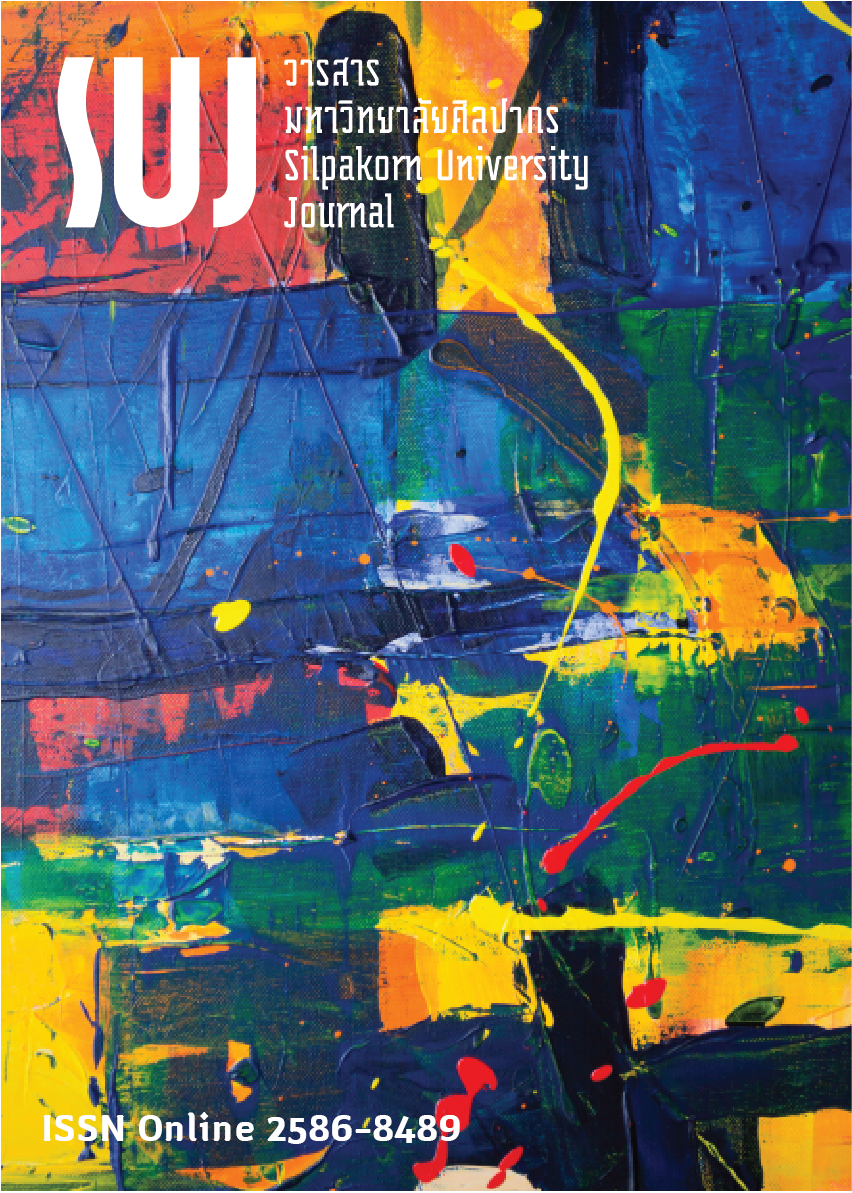ผลตอบแทนทางสังคมจากการลงทุนทำเกษตรอินทรีย์ในโครงการสามพรานโมเดล (Social return on investment of organic agriculture in Sampran Model project)
Main Article Content
Abstract
การศึกษานี้มีวัตถุประสงค์เพื่อศึกษาผลตอบแทนทางสังคมจากการลงทุนทำเกษตรอินทรีย์ในโครงการสามพรานโมเดล จากการสัมภาษณ์ผู้บริหารโครงการและตัวแทนกลุ่มเกษตรกร 11 กลุ่มในโครงการสามพรานโมเดล จำนวน 9 คน จากนั้นจึงนำข้อมูลที่ได้มาคำนวณหามูลค่าทางการเงินจากผลลัพธ์ด้านสังคม เศรษฐกิจ และสิ่งแวดล้อม ผลการศึกษาพบว่า ผลตอบแทนทางสังคมจากการลงทุนของการทำเกษตรอินทรีย์ในโครงการสามพรานโมเดล ภาพรวมคิดเป็น 1.45 กล่าวคือ ทุกการลงทุน 1 บาทส่งผลตอบแทนทางสังคมมูลค่า 1.45 บาท โดยในด้านสังคมนั้นเกษตรกรในโครงการมีการรวมกลุ่มและประชุมเดือนละ 1 ครั้ง ทำให้เกิดการแลกเปลี่ยนเรียนรู้ และร่วมกันแก้ไขปัญหาระหว่างสมาชิกเกษตรกรภายในกลุ่ม และสนับสนุนองค์ความรู้ โดยการจัดอบรมและศึกษาดูงานซึ่งมีอาจารย์มหาวิทยาลัย นักวิชาการ และปราชญ์มาให้ความรู้ต่าง ๆ แก่เกษตรกร เช่น การตลาด วิทยาการหลังการเก็บเกี่ยว และเมล็ดพันธุ์ เป็นต้น เกษตรกรนำความรู้ที่ได้มาปรับใช้กับการทำเกษตรอินทรีย์ และมีสุขภาพดีขึ้นเนื่องจากปริมาณสารเคมีตกค้างในเลือดอยู่ในระดับปลอดภัย ด้านเศรษฐกิจทางโครงการสนับสนุนช่องทางการตลาดให้กับเกษตรกร เช่น ตลาดสุขใจ ตลาดสุขใจสัญจร และวิสาหกิจชุมชน เป็นต้น ทำให้เกษตรกรมีรายได้จากการจำหน่ายผลผลิตอินทรีย์ในราคาที่เป็นธรรม ไม่ถูกเอารัดเอาเปรียบจากพ่อค้าคนกลาง เพราะเกษตรกรจำหน่ายผลผลิตเองโดยตรง และด้านสิ่งแวดล้อม เกษตรกรมีการหมุนเวียนใช้ทรัพยากรให้เกิดประโยชน์สูงสุด ไม่ใช้สารเคมีในการทำเกษตร และเก็บรักษาต้นพันธุ์หรือเมล็ดพันธุ์ไว้เพาะปลูกต่อไป
This study aims to explore social return on investment of organic agriculture in the Sampran Model project. Interviews with nine representatives of eleven farmer groups in the Sampran Model project and the project manager were carried out. In addition, the survey of each activity of the project was also conducted. The study revealed that the social return rate on Investment (SROI) from an organic agriculture in the Sampran Model project was 1.45, indicating that every 1 baht of investment, it could generate a social benefit to the investor for 1.45 baht. For the social aspect, the farmers had a group meeting once a month, thus this community exchanged, learnt and solved their problems among the farmers within the group. In addition, knowledge and training from lecturers, experts, and philosophers, such as postharvest, marketing, and seeds were provided. Farmers, therefore gained knowledge of organic agriculture and consequently became healthier since the residue of agricultural chemicals tested in blood was not found. In terms of the economic aspect, the project has promoted marketing channels such as Sookjai Market, Sookjai Sanjorn Market, and community enterprises. The farmers’ income derived from organic products at a fair price without being exploited by middlemen, because farmers sold their products to customers directly. For the environmental aspect, farmers made the most efficient use of resources, no chemicals used in agriculture, and the seedlings could be kept for planting later.
Downloads
Article Details
References
Bates, B. and Yentumi-Orofori, R. (2013). Social Return on InvestmentSROI Report. [Online]. Retrieved January 30, 2019 from http://www.socialvalueuk.org/app/uploads/2016/03/vcp_sroi_final_draft_complete.pdf
Biothai. (2011). Pesticides and Real Costs (สารเคมีกําจัดศัตรูพืชและต้นทุนที่แท้จริง). [Online]. Retrieved September 23, 2017 from http://www.biothai.net/sites/default/files/BriefingPesticideCOST.pdf
Bureau of Occupational and Environmental Diseases. (2015). Knowledge of Pesticide Risk Screening by Cholinesterase Reactive Paper for Public Health Officer in Primary Care Units (องค์ความรู้เกี่ยวกับการตรวจคัดกรองความเสี่ยงจากการสัมผัสสารเคมีกำจัดศัตรูพืช โดยกระดาษทดสอบโคลีนเอสเตอเรส). [Online]. Retrieved January 15, 2017 from http://envocc.ddc.moph.go.th/uploads/media/manual/Crp.pdf
Eakpaitoon, Suchart. (2011). A Study of Evaluation Using Social Return on Investment for Social Enterprise: A Case Study of Crab Bank, Chumphon Province (การศึกษาการประเมินผลด้วยเครื่องมือวัดผลตอบแทนทางสังคมจากการลงทุนต่อการประกอบการทางสังคม: กรณีศึกษาธนาคารปู จังหวัดชุมพร). Journal of Business Administration, 34(131): 61-79. [Online]. Retrieved February 21, 2017 from http://www.jba.tbs.tu.ac.th/files/Jba131/Article/JBA131Suchart.pdf
Kasetkaoklai. (2017). Thong Prasert Jackfruit “Engraft for Sale” Used a Small Area is Entitled to Rich (ขนุนทองประเสริฐ “ทาบกิ่งขาย” ใช้พื้นที่เพียงน้อยนิดก็มีสิทธิ์รวยได้). [Online]. Retrieved September 23, 2017 from https://www.kasetkaoklai.com/home/2017/05/ขนุนทองประเสริฐ-ทาบกิ่/
Lawlor, E., Neitzert, E., and Nicholls, J. (2008). Measuring Value: a guide to Social Return on Invesment (SROI). London: new economics foundation. [Online]. Retrieved March 17, 2017, from https://commdev.org/wp-content/uploads/2015/06/Measuring-Value-A-Guide-to-Social-Return-on-Investment.pdf
Matichon Online. (2017). Former Headman of Surin Province, Think Organic Fertilizer for Sales (Quality as Chemical Fertilizer) and Ready for Integrated Farming (อดีตผู้ใหญ่บ้านสุรินทร์เจ๋ง! คิดสูตรปุ๋ยอินทรีย์ขายเอง คุณภาพเท่าปุ๋ยเคมี พร้อมทำเกษตรผสมผสาน). [Online]. Retrieved September 23, 2017 from https://www.matichon.co.th/news/617364
Nanagarden. (n.d.). Tree Market (ตลาดต้นไม้). [Online]. Retrieved September 23, 2017 from https://www.nanagarden.com/ตลาดต้นไม้
Phoochinda, Wisaka. (2015). Guidelines for Community Environmental Management using Industrial Ecology (รายงานวิจัยฉบับสมบูรณ์ แนวทางการจัดการสิ่งแวดล้อมชุมชนโดยใช้หลักนิเวศวิทยาอุตสาหกรรม). [Online]. Retrieved February 21, 2017 from http://rc.nida.ac.th/th/%0Aattachments/article/207/1.%25 20รายงานวิจัยฉบับสมบูรณ์.pdf%0A
Photiphitak, Sukanda. (2017). Social Return on Investment of A Pig Farmunder Sustainable Development Project: A Case of A Company LTD (การวัดค่าผลตอบแทนทางสังคมของโครงการฟาร์มสุกรภายใต้การลงทุน ในโครงการที่มีการพัฒนาอย่างยั่งยืน: กรณีศึกษาบริษัท เอ จํากัด). [Independent Study]. Bangkok: Thammasat University.
Sathuwijarn, Sirichai. (2007). Various Baby Corn Production in Organic System (การผลิตข้าวโพดฝักอ่อนในระบบเกษตรอินทรีย์). Master’s dissertation, Kasetsart University, Bangkok, Thailand.
Songkroh, Manawin. (2014). Demand for Organic Products in Chiang Mai and Lampang (อุปสงค์ของผลิตภัณฑ์เกษตรอินทรีย์ในจังหวัดเชียงใหม่และลำปาง). [Research report]. Chiang Mai: Maejo University.
Sookjai Organic Agriculture Development Centre. (n.d.). Sampran Model Project (โครงการสามพรานโมเดล). [Online]. Retrieved March 21, 2560 from http://sampranmodel.com/
Sorndangkarnkaset. (n.d.). Seed (เมล็ดพันธุ์). [Online]. Retrieved September 23, 2017 from http://www.sorndangkarnkaset.com/seed.php
Sumetheeprasit, Chiraporn. (n.d.). SROI: Social Return of Public Service (No. 154) (SROI : ผลตอบแทนเชิงสังคมของบริการภาครัฐ (เรื่องที่ 154)). [Online]. Retrieved October 9, 2017 from https://chirapon.wordpress.com/2011/05/12/sroi-ผลตอบแทนเชิงสังคมของบ/


